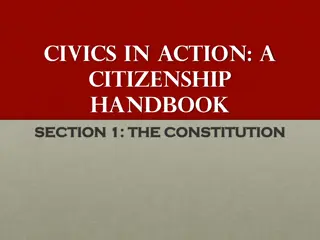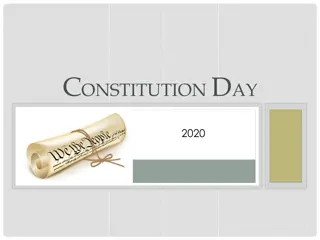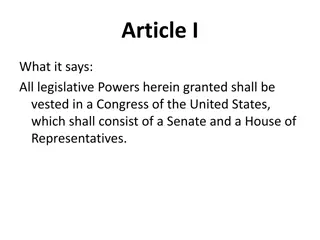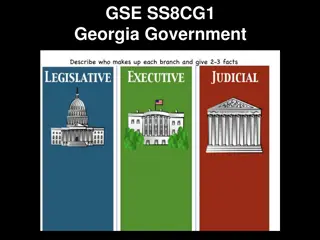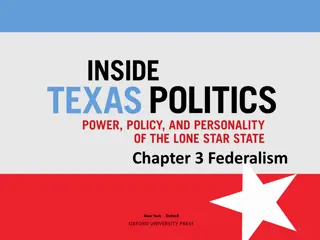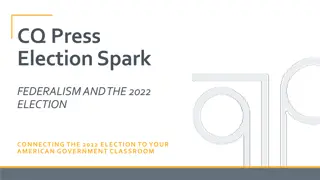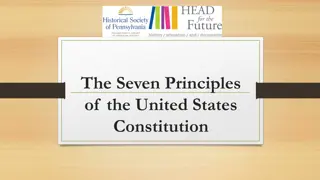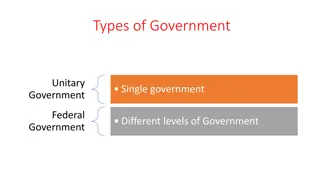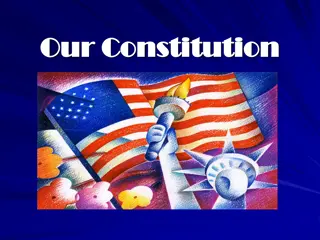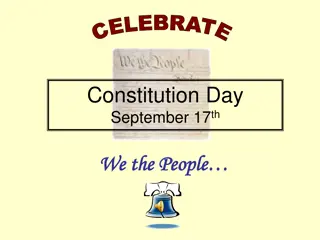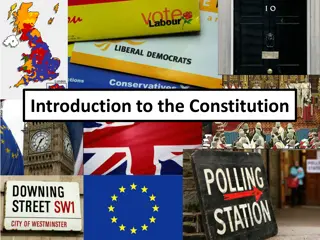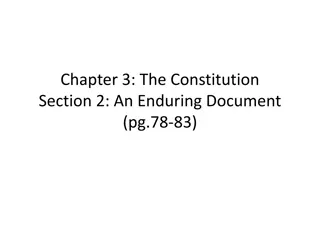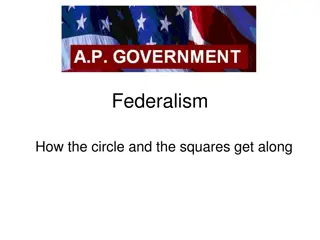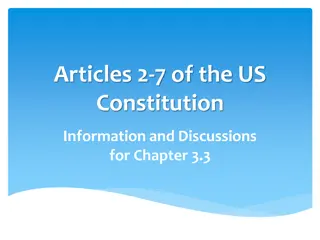Understanding the United States Constitution and Federalism
Delve into the history and significance of the United States Constitution, authored by James Madison in 1787. Explore the debate of ratification, Federalist vs. Anti-Federalist arguments, and the concept of Federalism, with a focus on the balance of powers between the central and state governments. Discover key concepts such as the Preamble, Ratification process, and Enumerated Powers, shedding light on the foundation of the U.S. government.
Download Presentation

Please find below an Image/Link to download the presentation.
The content on the website is provided AS IS for your information and personal use only. It may not be sold, licensed, or shared on other websites without obtaining consent from the author. Download presentation by click this link. If you encounter any issues during the download, it is possible that the publisher has removed the file from their server.
E N D
Presentation Transcript
United States Constitution Signed on September 17, 1787 Signed on September 17, 1787 In Philadelphia In Philadelphia Authored by James Madison Authored by James Madison
United States Constitution SSCG3 The student will demonstrate knowledge of the United States Constitution. SSCG4 The student will demonstrate knowledge of the organization and powers of the national government.
Preamble to the Constitution Preamble to the Constitution We the People of the United States, in Order to form a more perfect Union, establish Justice, insure domestic Tranquility, provide for the common defense, promote the general Welfare, and secure the Blessings of Liberty to ourselves and our Posterity, do ordain and establish this Constitution for the United States of America.
Debate of Ratification The Articles of Confederation: Document that created the first government of the United States of America. The United States Constitution: Strong document that replaced the Articles of Confederation because it was too weak. Ratification: The approval of a document by all of the states that is necessary for the document to be legal The Federalist Papers: Newspaper articles that were written to explain why the United States needed to ratify the United States Constitution.
Federalist vs Anti Federalist vs Anti- -Federalists Federalists Ratification debate: While many people thought that the Articles of Confederation were weak to protect America, another group believed that the Constitution was too strong and would take away peoples rights. Federalists: Group of politicians who fought to ratify the Constitution so that the US would have a strong central government; led by Alexander Hamilton. Anti-Federalists: Group of politicians to opposed the ratification of the Constitution because they believed that small, state governments were less likely to take away peoples rights; led by Thomas Jefferson
Federalism Federalism: System which creates a separation of powers by giving some powers to the central government and other powers to the state governments. Enumerated Powers: Powers that were specifically given to the central government by Articles 1, Sec 8 of the US Constitution.
Federalism Cont. Reserved Powers: Powers that only the state governments have because they were not given to the central government; These are protected by the 10th Amendment to the US Constitution. Concurrent Powers: Powers that are shared by the central and state governments in the system of Federalism
Federal vs. State Federal Government: The central government in Washington DC; Makes laws for the whole country. Supremacy Clause: States that the Federal Government always wins when its laws conflict with the laws of the states; Found in Article 6 of the US Constitution.
Federal vs. State Necessary and Proper Clause: (Elastic Clause) Says that the Federal government can give itself any power it needs to take care of the people of the United States. Found in Article 1 of the US Constitution. Implied Powers: Powers that are not specifically given to the Federal government, but that the Federal Government takes anyway because of the Necessary and Proper clause.
Enumerated Powers Article 1, Sec. 8 Article I of the Constitution says that the Federal government can: Create a military to defend the country from foreign attack. Declare War Coin money Create all agreements with other nations Making laws about interstate (from state to state) trade Creates all immigration and naturalization laws Establish Post Offices Establish Lesser Courts than the US Supreme Court
Reserved Powers The 10th Amendment says that all powers that are not specifically given to the Federal government by the Constitution are reserved for the states (or people). Powers that are reserved for the states include: Providing public education Creating all traffic laws Laws regulating the sale of cigarettes and alcohol
Concurrent Powers Some powers are given to the Federal government, but the state is allowed to do them too, including: Levy Taxes Create courts and rules for the courts Build roads
Article 1 ---Legislative Branch Section 1- All legislative Powers herein granted shall be vested in a Congress of the United States, which shall consist of a Senate and House of Representatives. House of Representatives House of Representatives Section 2- The House of Representatives shall be composed of Members chosen every 2nd Year by the People of the several States, and the Electors in each State shall have the Qualifications requisite for Electors of the most numerous Branch of the State Legislature. (Population)
House of Representatives Cont. House of Representatives Cont. No Person shall be a Representative who shall not have attained to the Age of 25 Years, and been 7 Years a Citizen of the United States, and who shall not, when elected, be an Inhabitant of that State in which he shall be chosen. (population) Head of House Speaker of the House 2ndin Line to the Presidency 2 year Term---unlimited terms (as long as you keep getting elected)
Section 3- United States Senate The Senate of the United States shall be composed of 2 Senators from each State, chosen by the Legislature thereof (Now 17thAmendment), for 6 Years; and each Senator shall have 1 Vote. (Equality) Head of Senate- VPOTUS / President Pro Tempore 3rdin Line to the Presidency 6 year Term---unlimited terms (as long as you keep getting elected) 30 Years Old ONLY CONGRESS CAN DECLARE WAR
Article 2-The President of the United States The executive Power shall be vested in a President of the United States of America. He shall hold his Office during the Term of 4 Years, and, together with the Vice President, chosen for the same Term, be elected, as follows. 35 years old Term 4 years Max 8 Years (2 Terms no guarantee of reelection)
President of the United States---Cont. Must be Born in the United States POTUS- is Commander and Chief of ALL US Military Forces POTUS /VPOTUS must be from different states Must give a State of the Union every year to a joint session of Congress Upon advice of the US Senate, can make treaties.
Article 3-United States Supreme Court The judicial Power of the United States, shall be vested in one supreme Court, and in such inferior Courts as the Congress may from time to time ordain and establish. 9 Justices 8 Associate Justices 1 Chief Justice of the Supreme Court Nominated by POTUS confirmed by US Senate
Article 3-United States Supreme Court Cont Justices of the Supreme Court https://www.supremecourt.gov/about/biographies.aspx
Salaries of Federal elected officials---Today Reg. House and Senate- $174,000 SENATE LEADERSHIP Majority Party Leader - $193,400 Minority Party Leader - $193,400 HOUSE LEADERSHIP Speaker of the House - $223,500 Majority Leader - $193,400 Minority Leader - $193,400
Salaries of Federal elected officials---Today President $400,000 ( Trump declined salary) Vice President $230,700 Chief Justice, U.S. Supreme Court $255,500 Assoc. Justice, U.S. Supreme Court $244,400
POTUS Pension- His pension payment will be $207,800 for the upcoming year, about half of his presidential salary. Obama and every other former president also get seven months of "transition" services to help adjust to post-presidential life. The ex- Commander in Chief also gets lifetime Secret Service protection as well as allowances for things such as travel, office expenses, communications and health care coverage.



